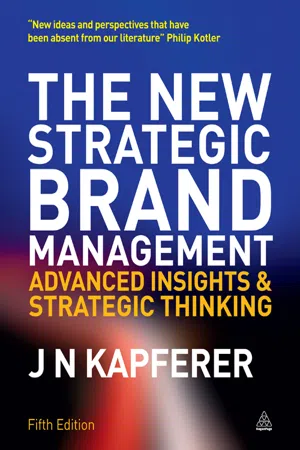Marketing
Brand Equity
Brand equity refers to the value and strength of a brand, based on customer perceptions and experiences. It encompasses brand awareness, loyalty, and associations, which can influence consumer behavior and purchase decisions. Building and maintaining strong brand equity is crucial for long-term success and competitive advantage in the market.
Written by Perlego with AI-assistance
Related key terms
1 of 5
10 Key excerpts on "Brand Equity"
- eBook - PDF
- Mark S. Glynn, Arch G. Woodside, Mark S. Glynn, Arch G. Woodside(Authors)
- 2009(Publication Date)
- Emerald Group Publishing Limited(Publisher)
Brand Equity is the true differentiation that a brand has from the competition, or the worth derived by a brand, from consumers ( Davis & Doughlass, 1995 ). One of the most popular definitions, which is now widely accepted in the branding literature, is that by Aaker (1991, p. 15) , in which Brand Equity is ‘‘a set of brand assets and liabilities linked to a brand, its name and symbol, that add to or subtract from the value provided by a product or service to a firm and/or to that firm’s customers.’’ The common point among the above definitions is that Brand Equity is the added value or the premium of the product to a consumer that is attributable to the brand name ( Wood, 2000 ). In terms of approaches, the discussion of Brand Equity is generally divided into two main streams. One stream focuses on the financial approach, or company-oriented view, which focuses on the value provided to brand owners. The other stream focuses on the customer perspective, which refers to the relationship between the Building Brand Equity 121 customer and the brand ( Wood, 2000 ). The following section discusses in detail these two main streams of Brand Equity research. Financial Approach to Brand Equity The financial approach refers to Brand Equity as a viable asset for manu-facturers ( Davis & Doughlass, 1995 ). This asset is defined as the incremental cash flow resulting from revenues of products with a brand name over those of unbranded ones ( Shocker & Weitz, 1988 ; Simon & Sullivan, 1993 ). The reasons for the development of this research stream are based on the requirement to set a price when the brand is sold and provide an index to attract investors or stakeholders as an intangible asset on a balance sheet ( Feldwick, 1996 ). Three popular methods for measuring Brand Equity from a financial approach exist. The most common measures focus on stock prices and brand replacement ( Myers, 2003 ). - eBook - ePub
The New Strategic Brand Management
Advanced Insights and Strategic Thinking
- Jean-Noël Kapferer(Author)
- 2012(Publication Date)
- Kogan Page(Publisher)
It is time to structure and organize the many terms related to brands and their strength, and to the measurement of Brand Equity. The official Marketing Science definition of Brand Equity is ‘the set of associations and behavior on the part of a brand’s customers, channel members and parent corporation that permits the brand to earn greater volume or greater margins than it could without the brand name’ (Leuthesser, 1988).This definition is very interesting and has been forgotten all too quickly. It is all-encompassing, reminding us that channel members are very important in Brand Equity. It also specifically ties margins to brand associations and customers’ behaviour. Does it mean that unless there is a higher volume or a higher margin as a result of the creation of a brand, there is no brand value? This is not clear, for the word ‘margin’ seems to refer to gross margin only, whereas brand financial value is measured at the level of earnings before interest and tax (EBIT).To dispel the existing confusion around the phrase Brand Equity, created by the abundance of definitions, concepts, measurement tools and comments by experts, it is important to show how the consumer and financial approaches are connected, and to use clear terms with limited boundaries (see Table 1.2 ):- Brand assets. These are the sources of influence of the brand (awareness/saliency, emotion, image, strength of relationship with consumers), and patents.
- Brand strength at a specific point in time as a result of these assets within a specific market, competitive environment and business model. Brand strength is captured by behavioural competitive indicators: market share, market leadership, loyalty rates and price premium (if one follows a price premium strategy).
- Brand value
- eBook - PDF
- J. Lindemann(Author)
- 2010(Publication Date)
- Palgrave Macmillan(Publisher)
CHAPTER 4 Brand Equity: THE MARKETER’S VIEW ON BRAND VALUE At the time financial markets started recognizing the value of intangible assets and brands marketing academics in the US, in the early-1990s, also attempted to conceptualize the brand as a business asset. The result was the concept of Brand Equity which capitalized on a finan- cial term to define a marketing concept. The term was made popular by the publications of David Aaker and Kevin Keller. Aaker described Brand Equity as a “set of assets (and liabilities) linked to a brand’s name and symbol that adds to (or subtracts from) the value provided by a product or service to a firm and /or that firm’s customers.” 1 The main asset categories comprised awareness, loyalty, perceived quality, and other brand specific associations. Despite the use of the term equity, the framework consisted of a combination of market research metrics. Aaker later expanded the framework to include metrics from other mod- els, most notably Y&R’s brand asset evaluator and Interbrand’s brand strength assessment. The resulting measurement framework comprised the following metrics: 1. willingness to pay a price premium; 2. satisfaction/loyalty; 3. perceived quality; 4. leadership/popularity; 5. esteem/respect; 6. perceived value; 7. personality; 8. trust and admiration for the organization; 9. differentiation; 10. market share; 11. price differential; and 12. distribution depth/coverage. 23 T H E E C O N O M Y O F B R A N D S As the broad set of metrics suggests the framework is more a guid- ance for the issues and themes to consider than a clear quantitative model. Aaker acknowledged that while all these measures have diag- nostic value, management efforts should focus on a minimum of one to a maximum of four relevant metrics. Selecting the relevant metrics requires educated judgment. - eBook - PDF
Competitive Success
How Branding Adds Value
- John A. Davis(Author)
- 2014(Publication Date)
- Wiley(Publisher)
Brand value is simply a measure of the difference of the net present cash- flows from a branded offering over those of a lesser known or even unbranded competitor. Correspondingly, brand value captures the premium the market attaches to a stronger brand over a weaker one. [Competitive Success] [17] As we will learn in Chapter 2, brand value is often a substantial percentage of total firm value, so management is paying more attention to this measure than ever before. Brand Equity is a related term that often creates confusion with brand value. Brand Equity reflects the customer’s perception either for or against the brand and, correspondingly, it can be positive or negative. To create Brand Equity firms must use tactics, including synchronized marketing and operations activities, to align their own organization toward a common set of objectives that ultimately attract and retain the interest of valuable cus- tomers. The accumulation of Brand Equity activities builds brand value. This can create organization tension, from determining clear brand objectives to internal accountability issues to delivering on brand promises, which will be discussed in Chapter 7 . Interestingly, this holistic definition of brand applies to B2C and B2B organizations, although you will learn important differences in tactical execution in Chapters 8– 10 that are relevant to each organization-type. Consider brand value analogous to the market value of your home and Brand Equity similar to the individual investments and contributions you make in your home over time. Each individual investment improves your home, increases your financial stake and, if the market agrees, enhances the overall value of your home. Of course, as we will see, external factors beyond our control can affect brand value. Management’ s task is organizing and monitoring firm actions (both people and program) to ensure the most effective use of resources so that brand value is enhanced. - eBook - PDF
- Emerald Group Publishing Limited(Author)
- 2015(Publication Date)
- Emerald Group Publishing Limited(Publisher)
Three principal perspectives have been adopted by the different constituencies of the branding research community in an attempt to understand Brand Equity: the financial perspective, the customer per-spective, and a combination of these two perspectives. Financial-based Brand Equity explores the worth of a brand in the financial market and considers the incremental 184 Jing Bill Xu and Andrew Chan cash flow or additional added value that is accrued to a firm by a brand name as compared to an equivalent unbranded product ( Farquhar, 1989 ). From this per-spective, well-known hotel brands impose some intangible value, compared to other seemingly homogeneous services, and this has an impact on the financial market through increased market share and market value. The customer perspective investi-gates Brand Equity at the consumer level. Customers are both the stakeholders of companies and the target of marketing communications ( Duncan and Moriarty, 1998 ). Equity, or benefits, is what customers unconsciously create and retain for the hotel and the brand. This study, which to some extent adopts the consumer perspective, borrows the Brand Equity theory initiated by Aaker (1991) and Keller (1993) . Aaker (1991 , p. 16) defined Brand Equity as “the set of assets (and liabilities) linked to a brand’s name and symbol that adds the value provided by a product or service to a firm and/or that firm’s customers.” He categorized Brand Equity into four dimensions: brand awareness, brand association, perceived quality, and brand loyalty. Keller (1993 , p. 8) disregarded the behavioral aspect and viewed Brand Equity as “the differential effect of brand knowledge on consumer response to the marketing of the brand.” The current study combines the propositions of these two pioneering propositions and considers brand knowledge to be a determinant of brand loyalty, according to the classical model of the “hierarchy of effects” ( Lavidge and Steiner, 1961 ). - eBook - PDF
- John M. T. Balmer, Shaun M. Powell, Joachim Kernstock, Tim Oliver Brexendorf, John M. T. Balmer, Shaun M. Powell, Joachim Kernstock, Tim Oliver Brexendorf(Authors)
- 2016(Publication Date)
- Palgrave Macmillan(Publisher)
124 Richard Jones consciousness; behavioural Brand Equity, that is, the consumer’s behav- ioural response to the brand (or that which can be directly attributable to the brand); and, thirdly, financial equity, that is, the financial impact of the brand as expressed through return on investment, profit, turnover, price-to-earnings ratio etc. Major research streams in relation to Brand Equity are concerned with: brand recognition and recall; 37 loyalty, perceived quality, perceived quality and associations; 38 brand image; 39,40 and purchase intention/ commitment. 41 Brand Equity is seen both in business-to-consumer and B2B markets in relation to rational and emotional responses to the brand, 42 that is customers’ beliefs about and attitudes to brand attrib- utes. While attributes lie within the brand, the Brand Equity concept attempts to translate these attributes in terms of the associations of the brand in the minds of the customer. This paper contends, however, that these measures of Brand Equity do not adequately incorporate new notions of the value of interaction and the co-creation of value. In recent years there have been attempts to examine Brand Equity across the entire value chain. 43 Brand Equity measures, such as those outlined by the authors above, may encourage brand managers to overly concen- trate on the surface of the brand, and not look at how the brand creates long-term value for its customers. Approaches to Brand Equity need to go beyond end customers and their knowledge of the brand. Thus, for example, customer awareness is a prerequisite for brand success, but does it give value in its own right? The online retailer Boo! had a high level of brand awareness, but this apparently did not contribute to brand value, and ultimately was not a source of Brand Equity. - eBook - PDF
Restaurant Franchising
Concepts, Regulations and Practices, Third Edition
- Mahmood A. Khan(Author)
- 2014(Publication Date)
- Apple Academic Press(Publisher)
This is the holistic mental picture that the consumer has once the branding is completed. Franchisors will fi nd it much more pro fi table to come up with a unique concept for a franchise rather than duplicating what is already in existence. This is a challenge that has been successfully met by many restaurant franchises that stay in the business for a long period of time. Branding should therefore take into consideration (a) attributes of the menu items, (b) attributes of the service to be provided, (c) bene fi ts that are provided to the end users, (d) difference(s) from existing brands, if applica-ble, and (e) value to the customer. This requires a thorough understanding of the consumer’s motivations and needs. Considering all of the involved factors, an appealing image has to be created about products and services in the minds of the consumers. Brands should therefore convey a consistent message that is matched by the performance at all times and at all locations. Brand Equity is a term used to show the value that is endowed in a product or service. It may be re fl ected in customer’s perception of the value received as portrayed by prices, market share, and added bene fi ts. The value of a brand eventually rests in the minds of the consumers. A brand is said to have pos-itive customer-based equity when consumers’ reaction is favorable. If the reaction is less favorable, it is considered as negative consumer-based equity. Thus Brand Equity arises from the differences in consumer response based on the knowledge of consumers. Brand knowledge includes all thoughts, feelings, images, experiences, and beliefs associated with the brand. Thus in order to develop and maintain Brand Equity, marketing efforts should be directed toward ensuring that customers have the right type of experiences, which can be termed as “memorable experiences.” These experiences for restaurant franchises include food, service, marketing, and promotion. - eBook - ePub
Brand Equity & Advertising
Advertising's Role in Building Strong Brands
- David A. Aaker, Alexander L. Biel, David A. Aaker, David A. Aaker, Alexander Biel, David A. Aaker, David A. Aaker, Alexander Biel(Authors)
- 2013(Publication Date)
- Psychology Press(Publisher)
Part III The Role of Advertising in Creating Brand EquityPassage contains an image
Chapter 10 Advertising, Perceived Quality, and Brand Image
Amna Kirmani Valarie Zeithaml Fuqua School of Business, Duke UniversityDOI: 10.4324/9781315799537-13In the past few years, marketing managers and academics have shown increasing interest in what constitutes and affects Brand Equity (Aaker, 1991 ). This interest has highlighted a number of unresolved issues or questions:- A fundamental issue involves the meaning of Brand Equity and its similarity to related concepts, such as brand name and brand image.
- Another issue is the relationship between Brand Equity or image and perceived quality, which is sometimes used as a measure of these brand concepts.
- As managers try to influence brand image, the issue of how advertising can affect such images becomes important (Park, Jaworski, & MacInnis, 1986).
We distinguish Brand Equity from brand image in terms of perspective. Brand Equity is a managerial concept: Managers engage in strategies (e.g., advertising, pricing) designed to build positive Brand Equity for their products. On the other hand, brand image is the perceptual concept of a brand that is held by the consumer (e.g., Dobni & Zinkhan, 1990 ). Biel (1991) made a similar distinction elsewhere in this book. He distinguished Brand Equity (a financial variable) from brand image (a customer or marketing variable), and he showed that brand image affects Brand Equity. Brand Equity and brand image are highly related terms because in building Brand Equity, managers attempt to influence consumer perceptions of a product (i.e., develop a positive brand image).Aaker (1991) - eBook - PDF
Pharmaceuticals-Where's the Brand Logic?
Branding Lessons and Strategy
- Giles David Moss(Author)
- 2016(Publication Date)
- CRC Press(Publisher)
All rights reserved. doi: 10. I300/5836-02 19 mind of consumers as a set of tangible (rational) and intangible (irrational) benefit^.^ A brand “is the aura that surrounds a product or service that communicates its benefits and differentiates it from the compe- tition for the con~umer.”~ Brand management is a process that requires resources and fo- cus from all functions, within a company, to succeed in one stra- tegic intent-creating a difference. The fundamental task is to transform the product category.s 9 “Brand Equity is a set of assets (and liabilities) linked to a brand’s name and symbol that adds to (or subtracts from) the value pro- vided by a product or service to a firm and/or that firm’s custom- ers.” The major asset categories being brand name awareness, brand loyalty, perceived quality, and brand associations.”6 Given that there is general confusion concerning branding, even in the fast moving consumer goods (FMCG) area, there is little real sur- prise that an industry dominated by mass sales forces, multiple cus- tomers, patent defense lawyers, and huge R&D organizations is going to find branding difficult to pin down. The brand concept, as indicated in the above definitions, goes beyond the product concept. A product delivers certain tangible benefits. A brand offers additional values that are both tangible and intangible, adding emotion to rational choice. A brand can be considered as the added value of marketing investments made in a certain product. The Mercedes brand, for example, is registered in the minds of con- sumers as a brand offering a set of tangible benefits (solidity, reliabil- ity, and Germanic quality) and intangible benefits (success, status), linked to what the brand represents. Some brands focus more on tangi- ble benefits (Volvo, Gillette, and Pampers) while others more on in- tangible benefits (Coca-Cola, Perrier, and Marlboro) dependant on their market. All have managed to create strong associations in the consumer’s mind. - eBook - PDF
- Barton A Weitz, Robin Wensley, Barton A Weitz, Robin Wensley(Authors)
- 2002(Publication Date)
- SAGE Publications Ltd(Publisher)
(1989) Managing Brand Equity. Marketing Research , 1 (September), 24–33. Farquhar, P.H. & Herr, P.M. (1992) The dual structure of brand associations. In Brand Equity and Advertising: Advertising’s Role in Building Strong Brands , edited by David A. Aaker & Alexander L. Biel. Hillsdale, NJ: Lawrence Erlbaum Associates, pp. 263–77. Farquhar, P.H., Han, J.Y., Herr, P.M. & Ijiri, Y. (1992) Strategies for leveraging master brands. Marketing Research , 4 (September), 32–43. BRANDING AND Brand Equity 173 Feinberg, F.M., Kahn, B.E. & McAllister, L. (1992) Market share response when consumers seek variety. Journal of Marketing Research , 29 (May), 227–37. Feldwick, P. (1996) Do we really need ‘Brand Equity’? The Journal of Brand Management , 4 (1), 9–28. Fournier, S.M. (1998) Consumers and their brands: devel-oping relationship theory in consumer research. Journal of Consumer Research , 24 (3), 343–73. ——— (2000) Dimensioning brand relationships using brand relationship quality. Presentation at the Association for Consumer Research annual conference. Fournier, S.M. & Yao, J.L. (1997) Reviving brand loyalty: a reconceptualization within the framework of con-sumer – brand relationships. International Journal of Research in Marketing , 14, 451–72. Fournier, S.M., Dobscha, S. & Mick, S. (1998) Preventing the premature death of relationship marketing. Harvard Business Review , January–February, 42–51. Foxman, E.R., Berger, P.W. & Cote, J.A. (1992) Consumer brand confusion: a conceptual framework. Psychology & Marketing , 9 (2), 123–41. Gardner, B.B. & Levy, S.J. (1955) The product and the brand. Harvard Business Review , March–April, 33–9. Golder, P.N. (2000) Historical method in marketing research with new evidence on long-term stability. Journal of Marketing Research , 37 (May), 156–72. Graeff, T.R. (1996) Image congruence effects on product evaluations: the role of self-monitoring and public/ private consumption.
Index pages curate the most relevant extracts from our library of academic textbooks. They’ve been created using an in-house natural language model (NLM), each adding context and meaning to key research topics.









